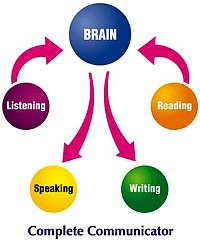 |
Learn English Locally, Apply It Worldwide! Enjoy Regular Practice |
'Teach-OK!' - The Whole Brain Activator
The 'Teach-OK!' technique is another one of the most popular techniques in Whole Brain Teaching. Students love it because it brings more life and interaction in the classroom and the teachers love it because it engages students in a very effective way, thus leveraging the learning process impressively.
The script for 'Teach-OK!'
Teacher: When I clap twice and say 'Teach!' ... You clap twice and say 'OK!' [Pause] ... [clap-clap] Teach!
Students: OK!
Teacher: However I say ' Teach!', that's how you say 'OK' [Pause] ... [clap-clap] Teeeach!
Students: [clap-clap] OOOh-Kay!
Teacher: Good! Now, after you said ‘OK!’ you immediately turn to your partner and teach them the classroom rules! [Pause] … [clap-clap] Teach!
Students: [clap-clap] OK! [Students teach their partners the 5 classroom rules.
After this practice, they should be able to teach anything you taught them previously. Remember, you teach them in micro-teaching sessions, precisely in order for them to repeat it to their partners. The longer you talk, the more students you lose!
This technique, coupled with the ‘Class – Yes!’ technique, will give you this pattern:
Teacher: Class!
Students: Yes!
Teacher: Speaks briefly, teaching part of the current lesson. [Pause] ... [clap-clap] Teeeach!
Students: [clap-clap] OK!
Students: They now teach each other aloud, over and over what you’ve said, firstly as a matter of fact and then using gestures. This engages their motor cortex – the brain’s most powerful learning centre.
While the teaching goes on among the students, the teacher walks around the room, listening in and checking comprehension, after which the micro-teaching process starts over. This is important. Done correctly, it will reduce the number of questions at the end of the week, when some of the students who haven’t understood will ask, others will only reveal their lack of comprehension in their test, by which time it’s too late to address it. The trick is to check not the best, nor the worst students, but the ones ‘in-between’ – the border-liners, those who may get it or they may not. If you catch them at this point, you can easily increase the numbers of those who do understand the content of your lesson.
Working in pairs, the students teaching use gestures and the students listening mirror the gestures. Praise students who are using gestures and prompt those who aren’t doing so.
Micro-teaching
You need to decide how long your teaching session will be, according to your students’ capacity to retain the information in order to repeat it confidently. Start with a short session of 10-15 seconds (for example a paragraph, or just a couple of sentences), then add another teaching block to it, and then another one, asking them to teach each other every time you give them new information. Then you can extend your teaching sessions by the end of the lesson, when you review things with them, by which time they should have committed some of that information to the long term memory bank.
How does the brain work during the learning process?
In the front of the brain is the Wernicke’s Area, which engages in listening activities;
At the back of the brain is the Hippocampus, where the memories are formed, by repetition;
If you compare the brain’s capacity to a normal container, for example a glass and the teaching by repetition to the act of filling the glass with water, you get the image of this container overflowing when too much water is poured in, just as the brain filling when too much talking takes place… By pouring an excessive amount of water into the glass, this will not increase the capacity – equally, if you talk for too long, you can expect your students’ brains not to swell, in order to take in this information, but to burn out instead!
In Whole Brain Teaching, in addition to the Wernicke’s Area and the Hippocampus, you also activate the following areas: the Pre-Frontal Cortex, by using the ‘Class-Yes!’ and the ‘Teach-OK! Techniques; Broca’s Area (in charge of speaking), the Motor Cortex (in charge of movement), the Visual Cortex (in charge of seeing), by using the ‘Teach-OK!’ technique; and, on the whole, the Limbic System (in charge of emotions) is activated by making the whole experience a fun and memorable one.
This is why the ‘Teach-OK!’ technique is also called the whole brain activator.
The learning process is as follows: input from the senses goes into the short term memory, therefore it is advisable to limit this to 3-7 items; the step from here, to the strong long term memory is achieved by much repetition, whilst activating many brain areas.
Whole Brain Teaching Lesson Planner
Split your lesson plan into 3 columns:
- The left column for pointers to implement the ‘Class-Yes! Attention Getter;
- The middle column for fractions of the content of your lesson, preferably with the gestures you’re preparing for each one – this is your micro-teaching and you need to scaffold your points;
- The right column for pointers to implement the ‘Teach–OK!’ technique.
Using gestures in WBT
Why are gestures important?
The motor cortex allows for the highest memory retention, whereas the Wernicke’s area allows for the lowest memory retention. The 3 main reasons are:
- Motor memory last for decades (once you’ve learned how to ride a bike, you will not forget easily);
- The visual cortex is also engaged when using gestures (what is easier to remember – the name of a person or his/her face?);
- You can immediately see who’s on task, when the students use gestures while mirroring or teaching their partners.
Three kinds of gestures:
- Casual: you keep talking and just make casual gestures along, as you speak;
- Graphic gestures: use these to accompany a story or to describe a process;
- Memory gestures: these are linked to the standard concepts you’re using in your teaching, i.e. numerator/denominator, multiplication, verb, adjective, preposition, etc.
Leadership Training
For advanced WBT practice you can train a leader to cue this technique. You would select a deserving student to become the leader to cue ‘Teach-OK!’ and you show them how to use various tones of voice for the cue. When you then point to the leader, at certain moments during the class, they will clap twice, say ‘Teach!’ and the other students will say ‘OK!’.
Train the leaders for as long as necessary, until they get over their lack of confidence or they get on track with their speed. Rehearse and you’ll get a good leader, more fun in the classroom and more motivation for other potential future leaders. Let them be creative and inspire on-task laughter, which is good for the feel-good factor as well as for the opening up for the learning process.
Critical thinking during WBT classes
As a teacher, you may decide when you ask students comprehension questions, then let them do some thinking (individually or in pairs), let them come up with their own answers and then do the ‘Teach-OK!’.
Introducing this would take the teaching between partners to a higher level of communication, involving shared active thinking. Critical thinking, according to the Greeks, began with dialogues, after all.
Use the Because Clapper to explain certain points.
English Corner Weekly E-zine
Packed with knowledge, published on Tuesdays.
Get yours here!
Our Archives:
Our lessons in the names and sounds of letters, short & long vowel sounds, CVCs, CCVCs, CVCCs, sight words, vowel and consonant contrasts, etc.
Our lessons will help increase your vocabulary, word recognition, find meaning in context, skills for TOEFL tests and other games, for fun.
Here we shall build some lessons to help you improve your writing skills.
Lots of lessons: cause & effect, comparisons, linking signals, relative clauses, presenting information, expressing emotions and grammar games, of course. We had more lessons on: intensifying adverbs and phrasal verbs, expressing various concepts such as addition, exception, restriction and ambiguity. Lately we started some exercises: likes/dislikes, frequency adverbs (twice), verb tenses, etc.
Learn how to build a website, by using the SBI! system - start from the basics, developing a site concept and a niche, supply and demand, learn about profitability and monetization, payment processing, register domain, website structure and content as a pyramid. Also learn about the tools I'm using to build this website. We also covered how to build traffic, working with search engines, building a good system of inbound links, using social marketing and blogs with the SBI system, how to use Socialize It and Form Build It, how to publish an e-zine and how to build a social network in your niche.
We looked at a few games by now: Countable & uncountable nouns, Free Rice, Name That Thing, Spell It, Spelloween, the Phrasal Verbs Game, Preposition Desert, The Sentence Game, Word Confusion, Word Wangling, Buzzing Bees, and The Verb Viper Game.
Be prepared to play and learn more pretty soon.
